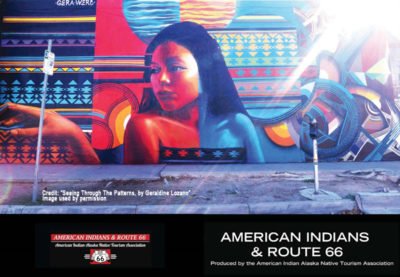- (800) 416-8102
- info@nativepartnership.org
- 16415 Addison Rd, Suite 200, Addison, TX 75001-3203
Route 66 and the Iconic American Indian
By Moderator
“Get your kicks on Route 66!”
While the historical route is known by most in the United States as one of its first highways, it was more famous for its classic portrayal of popular culture. Route 66 served as a major migration path in the 1930s during the dustbowl, as well as a popular route for tourists, both American and foreign. The highway spanned hundreds of rural communities, all unique in their own ways and many capitalizing on their own strengths by serving as pit stops, tourist locations, and vacation destinations along the route. With more than half the route cutting through Indian country, perhaps one of the most recognizable icons along Route 66 was that of the stoic American Indian.
 Several tribal communities endured the tourism of the route, mostly small communities not then in the best of economic conditions. As travelers passed through, they would encounter reflections of the marketing images shown along the route – its billboards with warriors and tipis. Tribal members often donned war bonnets and held games or traditional-seeming ceremonies for passersby, living up to the stereotypical Hollywood imagery and tales, to bring needed money into the community. Numerous tribes sacrificed this in favor of the needs of their people.
Several tribal communities endured the tourism of the route, mostly small communities not then in the best of economic conditions. As travelers passed through, they would encounter reflections of the marketing images shown along the route – its billboards with warriors and tipis. Tribal members often donned war bonnets and held games or traditional-seeming ceremonies for passersby, living up to the stereotypical Hollywood imagery and tales, to bring needed money into the community. Numerous tribes sacrificed this in favor of the needs of their people.
As Lisa Snell, publisher of Native American Times in Tahlequah, Okla. explains, “Because of the socio-economic conditions, what do you do? You take the job, you put on your buckskins, you put on your war bonnet and you have your picture taken. You do the job,” she said. “That’s been perpetrated through today. It’s still that image we have. It’s lingering.”
Similarly, Partnership With Native Americans (PWNA) recognizes that these images used so long ago continue to fuel stereotypes and misperceptions about Native Americans and Native culture today.
Some of the most recognizable tribes along Route 66 include the Navajo, Zuni and other pueblos. Each of these tribes commercialized their specialties, including food, pottery and jewelry, and staged shows open to the public. Maybe one of the more memorable elements brought to Route 66 were the roadside Navajo jewelry stands (not the Navajo fireworks stands Hollywood put into the mix in the film “Joe Dirt”). Through this, each tribe uniquely brought some of the nostalgia to Route 66, especially since some of the imagery borrowed from techniques tribes had used for hundreds of years.
Despite these images so popular at the time, all must seek to recognize and honor the true culture of these tribes. A partnership between the American Indian Alaska Native Tourism Association and the National Park Service, working with numerous tribes along the route, is doing just this – bringing light to true Native American culture through a project called “American Indians and Route 66.” The project recently unveiled a guidebook, highlighting new and classic locations along the route, and re-educating travelers on the tribes by accurately showcasing some of their unique practices, history and contributions to the region and the U.S.







